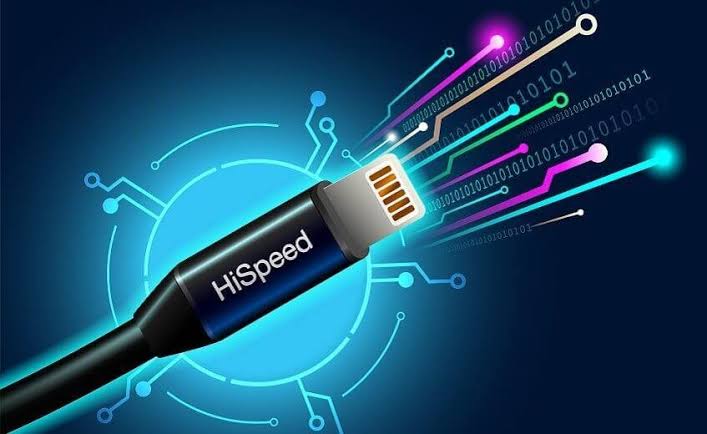Physical Address
60 Ekwema Cres, Layout 460281, Imo
Physical Address
60 Ekwema Cres, Layout 460281, Imo

Improving internet speed and connectivity is essential for businesses and households alike. When internet speeds begin to slow down, taking action to enhance your connection becomes crucial.
This can range from straightforward solutions like purchasing a new modem to more involved steps such as installing an Ethernet cable. Below, we explore the steps you can take to boost your internet speed.

Good internet speed is a highly sought-after asset for many households, and its quality depends on various factors. The definition of “good” speed varies based on the volume and nature of internet activities, such as simple web surfing, streaming videos, or remote work.
Below, we will delve into the recommended speeds and services based on household size and the type of activities being performed.
Also Read: How to Use MobileGPT Directly on WhatsApp
For basic web surfing, a relatively low bandwidth suffices, although a slightly faster connection is necessary for streaming videos.
When selecting an internet plan with upload and download speeds that align with your requirements, it’s essential to consider your daily online activities and choose accordingly. By performing some simple calculations, you can gauge your usage.
For example, sending a text-only email consumes roughly 10 kilobytes (KB), as per Verizon Wireless, a prominent Internet Service Provider in the United States.
Typically, loading a standard web page necessitates about 1 megabyte (MB), while audio streaming consumes approximately 51 MB per hour. Streaming standard-definition video consumes 500 MB per hour, and streaming high-definition video utilizes 1.6 gigabytes (GB) per hour.
Users who opt for lower broadband capacity than necessary might experience dissatisfaction with their internet experience.
Streaming video and videoconferencing necessitate higher speeds. If these activities constitute a significant portion of your daily internet usage, opting for faster internet service with low latency is essential.
Providers offering fiber optic connections deliver the fastest and most reliable service, with cable connections being a close second.

It’s crucial to understand your typical usage patterns and be mindful of any data caps imposed by your plan to avoid exceeding them. Doing so could lead to additional data charges or result in your Internet Service Provider (ISP) throttling, or slowing down, your speeds.
To put it into perspective, streaming one minute of standard-definition video consumes 11.7 megabytes (MB), high-definition video uses 41.7 MB, and 4K ultra HD video consumes 97.5 MB, equivalent to sending nearly 5,000 email messages.
Fiber internet services consistently maintain low rates of data loss (less than 0.4 milliseconds) and the lowest latency, ensuring minimal disruptions.
Also Read: LAPO USSD Code: How to Activate and Use it
Federal Communications Commission suggests that the ideal internet speed varies for households connecting multiple devices simultaneously. For two devices with moderate to heavy internet usage, a download speed of at least 25 Mbps should suffice. However, for three or more devices, a download speed of at least 100 Mbps would be more suitable.
For households with one or two users engaging in activities like streaming high-definition or 4K video, video conferencing, online gaming, or remote work, internet speeds ranging from 12 Mbps to 100 Mbps are reasonable.
Heavy internet usage, however, would require speeds closer to the higher end of that spectrum. Homes with three individuals using three or more connected devices should aim for speeds of up to 100 Mbps for moderate use, while heavy usage would necessitate 100 Mbps or more.
In households where four or more people are connected to the internet, download speeds of 100 Mbps or higher are recommended.
According to the FCC’s Twelfth Measuring Broadband America Fixed Broadband Report released in January 2023, most Internet Service Providers (ISPs) deliver their promised broadband speeds. The report evaluates 12 ISPs across various technology configurations, such as fiber, cable, DSL, and satellite. It notes that out of these providers, only one performed below 90% for actual-to-advertised download speeds.
Many plans offered by top Internet Service Providers provide incremental increases in speed for slightly higher costs. If you’re seeking faster speeds without a significant price hike, exploring these options can be beneficial.
Also Read: Update on LAPO Loans: How to Apply, Eligibility Requirements and Loan Packages
For remote work, a reliable internet connection is essential, supporting activities such as email communication, accessing cloud services, and participating in video conferences, which often involve sharing large files and consuming significant bandwidth.
According to Speedtest.net, video conferencing platforms like Zoom and Google Meet function optimally when connected to sufficiently fast internet. Zoom recommends speeds of approximately 4 Mbps for downloads and 3 Mbps for uploads for high-definition video conferencing with multiple participants. Similar recommendations are provided in Google’s support documentation.
When determining the required speed for your work-from-home setup, it’s crucial to be aware that low promotional prices may be for the lowest-tier internet speeds offered by ISPs. Additionally, the Federal Trade Commission advises verifying that the actual download and upload speeds match the ones advertised by your ISP.
Actual transmission speeds are influenced by factors such as the type of applications being used, the number of simultaneous users, and more.
ISPs with a fiber optic network, like Verizon Fios and AT&T, typically offer the fastest and most reliable internet speeds. Following fiber are cable connections, followed by other technologies such as fixed wireless (including 5G home internet), DSL, and satellite internet.
Now that we’ve established the criteria for fast internet service, let’s explore six ways to enhance internet speed, ensuring optimal performance for all online activities.
Have you ever experienced excellent connectivity in one room but a weak signal just a few feet away? This discrepancy is often due to Wi-Fi signals being obstructed or blocked by solid objects like walls and floors.
Experts recommend strategic placement of your router, ideally in a central location relative to areas with high-priority internet use. It’s best to position the router in an elevated spot rather than in a closet or under a cupboard. If your current ethernet cabling limits placement options, consider reconfiguring it to facilitate placing the router in an optimal location.
Furthermore, avoid placing your router and modem near microwave ovens, as they operate on the same frequency as most Wi-Fi signals (2.4 GHz), leading to interference. Similarly, wireless devices such as cordless phones, baby monitors, and Bluetooth speakers can disrupt Wi-Fi signals, so plan your setup accordingly.
If your device has an external antenna, adjusting its position may also enhance performance.
Modern routers often utilize dual-band technology, offering wireless signals at either 2.4 GHz or 5 GHz. While the 5 GHz band generally delivers superior performance, it has a shorter range compared to the 2.4 GHz band.
If you’re experiencing interference or congestion on your current frequency band, consider switching to the alternative band. Given that many Internet of Things (IoT) devices operate on the 2.4 GHz frequency, this band can become crowded, affecting performance. Instructions for changing the Wi-Fi frequency band are available for Windows 10 users.
Similar to channels in other forms of communication, Wi-Fi channels can also experience congestion. In such cases, changing your Wi-Fi channel can alleviate issues. The 2.4 GHz band offers 11 channels, with channels 1, 6, and 11 recommended due to minimal overlap and reduced interference from other devices. On the other hand, the 5 GHz band provides 24 non-overlapping channels.
Mac users can utilize Wireless Diagnostics (by holding down Option and clicking the Wi-Fi icon) to identify optimal channels on both bands. Windows users can explore their channel options using tools like NetSpot or by running commands in Windows PowerShell. Once you’ve determined the ideal channel, access your router’s online interface to make the necessary adjustments.
A single bottleneck can significantly impact network performance, often stemming from outdated modem or router equipment. Older devices can lead to weaker signal strength, resulting in slower internet speeds and potential security vulnerabilities.
Although many home internet users rent equipment from their Internet Service Provider (ISP), purchasing your own modem and router can offer better performance and greater control over various features. Moreover, investing in equipment capable of handling higher speeds prepares you for potential upgrades to faster connections, such as 10Gbps.
While upgrading may involve an initial investment, the long-term benefits in terms of improved performance and security make it a worthwhile consideration.
Even with a high-performance modem and router in an optimal position, large spaces can still experience connectivity issues. Here are some options to address this:
Wi-Fi extenders or boosters extend the range of your Wi-Fi network by amplifying the signal. These devices are simple to set up, requiring only to be plugged in and connected. However, it’s important to note that the Wi-Fi signal from extenders may be weaker than the original signal.
Wi-Fi mesh network systems offer a comprehensive solution by replacing a single router with multiple devices that work together to enhance Wi-Fi coverage throughout your space.
Powerline adapters consist of two devices: one connected to your router and another plugged into a wall socket in the room where improved connectivity is needed. These devices utilize the electrical wiring within your walls to deliver a stronger signal in that particular area.
Similar to how unnecessary applications can slow down a computer, having numerous devices operating on the same Wi-Fi channel can lead to network slowdowns. This can occur if devices such as smart TVs, gaming consoles, and other smart home devices are all running simultaneously on your network.
To address network slowdowns, consider removing non-essential devices from your network. While this may seem daunting, Wired recommends changing your Wi-Fi password and rebooting your router, which can quickly resolve the issue. However, keep in mind that you’ll need to reconnect all devices manually by changing their passwords.
Investing in your own router offers additional benefits, such as the ability to prioritize specific devices or services. This ensures that critical activities receive priority, preventing them from being interrupted by less essential tasks.
There’s ongoing debate regarding whether unplugging your router and modem for 30 seconds or more actually improves performance.
While HighSpeedInternet.com strongly advocates for this practice, other sources argue that while it can restore a dead internet connection, restarting your equipment may not significantly impact performance. However, these sources acknowledge that the restart process could prompt your router to select a better channel, potentially leading to improved performance.
Regardless of the debate, since a dead internet connection often correlates with poor performance, we recommend restarting your modem and router. It’s a simple step that likely won’t cause harm and could potentially resolve connectivity issues.
In conclusion, optimizing internet speed is essential for ensuring a seamless online experience, whether for work, entertainment, or communication.
By implementing the six strategies outlined in this article—adjusting router placement, optimizing frequency bands, upgrading equipment, extending network coverage, eliminating unnecessary connections, and periodically restarting your modem and router—you can significantly enhance your internet speed and overall connectivity.
Remember, the key factors influencing internet speed include the quality of your modem and router, the placement of your devices, network congestion, and the number of connected devices.
By addressing these factors and following best practices, such as using newer equipment, strategically placing routers, and optimizing frequency channels, you can enjoy faster and more reliable internet performance.
Investing time and effort into optimizing your internet speed not only improves your online experience but also increases productivity, reduces frustration, and ensures a smoother digital workflow. Stay proactive in monitoring and managing your network to make the most of your internet connection and stay ahead in today’s digital world.